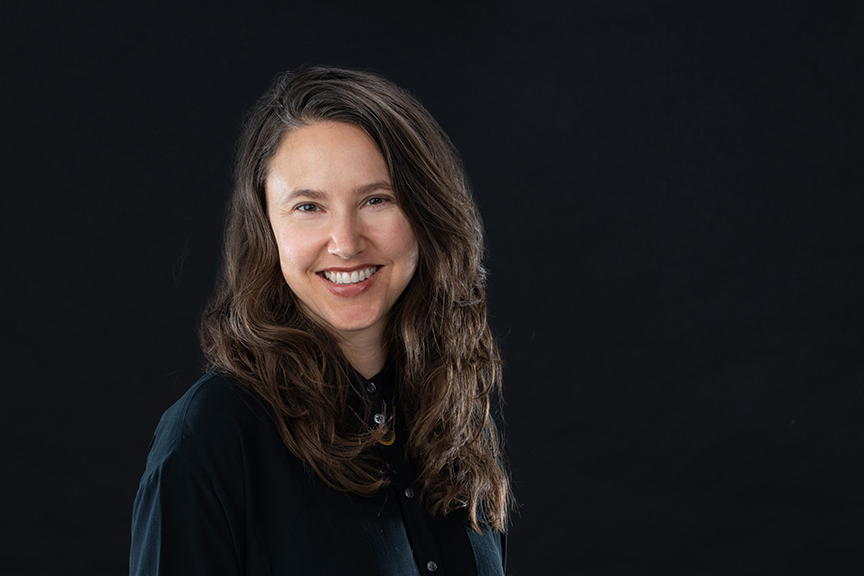
Katie Anania, assistant professor of art history in the School of Art, Art History & Design, has been named a Tyson Scholar in American Art for the spring 2022 semester at the Crystal Bridges Museum of Art in Bentonville, Arkansas.
“I was delighted to hear that I’d been named a Tyson Scholar,” Anania said. “The fellowships in American Art at Crystal Bridges are an unparalleled opportunity to work on a project in the company of like-minded thinkers. Living and working so close to a museum collection, too, makes the research and writing feel more urgent and exciting.”
Established in 2012, the Tyson Scholars Program supports scholarship that seeks to expand boundaries and traditional categories of investigation into American art and visual culture. Since its inception, it has supported the work of 46 scholars.
Anania will be spending the 15-week residential fellowship doing research for her second book project, “Devour Everything: Art and Hunger in the Age of Commodity Agriculture.”
“The book explores feminist art projects in the U.S., Mexico, and Argentina that used food as their primary material as they responded the Green Revolution of the 1950s, 60s, and 70s,” she said. “During this period, an astonishing array of artists used food as an artistic material and explored food’s absence in their work. They engaged in hunger strikes alongside farm workers and created promotional materials for hunger strikes. They seized food supply trucks to distribute powdered milk and other staples to rural families. They staged public performances to give away fruit, vegetables, and packaged foodstuffs to passersby; and they ran community gardens. By engaging with the ways food was grown, packaged, and served, these artists interrogated the emerging global art market in relation to other exploitative and damaging systems of production. This is the kind of book I’ve always wanted to write: one that incorporates art history, intersectional feminisms, food studies, performance theory and more.”
This will be Anania’s first visit to Crystal Bridges, which was founded in 2005 by the Walton Family Foundation. Their collection spans five centuries of American art from the 17th century to today and is comprised of 3,000 paintings, works on paper, sculpture, photography and new media.
She is looking forward to seeing the collection in person.
“As a professor at a land-grant university, I’m always looking for ways to center my academic work on local questions and problems, especially ones about food and water,” Anania said. “The Northwest Arkansas region has a wonderful community for thinking through these issues, including the Center for Agricultural and Rural Sustainability at the University of Arkansas and several labs at the University of Central Arkansas. I’m hoping to connect with faculty in Art History, Biology, and Latin American Studies there and possibly generate a public program or discussion at Crystal Bridges that connects to the art collection.”
She encourages anyone thinking about taking on a challenging archival or art historical project to do it.
“There are so many unseen historical narratives yet to uncover,” Anania said. “It’s one of the reasons I love object-based research—there’s always a new collection or a set of hidden materials to explore.”
Anania specializes in modern and contemporary art of the Americas, with an emphasis on temporary and ephemeral works like drawings, letters, tents, mobile clinics, packaging, and food. As a 2020 faculty fellow at the Daugherty Water for Food Institute at UNL, she uses multiple theoretical approaches, including blended methods in the environmental humanities, to investigate the ways that artworks act on the body to create new relationships between human beings and their surroundings.
Her current book project, “Out of Paper: Drawing, Environment, and the Body in 1960s America,” shows how drawing shifted from a private practice to a public one in the 1960s and 70s.
Earlier this year, Anania was named as Special Personnel on a four-year, NSF-funded grant of $6 million, which will study harmful algal blooms, nitrate-contaminated water and “dead zones” in oceans and lakes. For this project she will lead a workshop series called “Art, Data, and Environment/s” that uses feminist art to visualize water contamination. She organized a related exhibition, “The Nature of Waste: Material Pathways, Discarded Worlds,” which will open on Aug. 13 at the Sheldon Museum of Art.